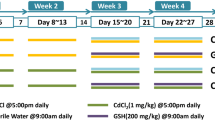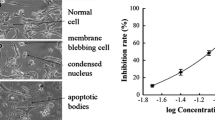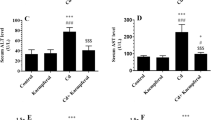Abstract
Pretreatment with zinc produces tolerance to several cadmium toxic effects. This study was performed to further elucidate the mechanism of zinc-induced tolerance to cadmium cytotoxicity in a rat hepatic stellate cell line (CFSC-2G). Twenty four hours after seeding, cells were treated with 60 μmol/L ZnCl2 for 24 h. Following zinc pretreatment, cells were exposed to 3 μmol/L and 5 μmol/L CdCl2 for an additional 24 h. The toxicity of cadmium was significantly reduced in the zinc-pretreated cells. Zinc pretreatment produced a decrease in lipid peroxidation damage of cadmiumtreated cells. Glutathione cell content diminished 33% and 43% as a result of 3 μmol/L and 5 μmol/L CdCl2 treatment, respectively. Cell pretreatment with zinc recovered glutathione content at control cells level. Catalase and glutathione peroxidase activities were also recovered to control values with zinc pretreatment. Cadmium (5 μmol/L) was able to induce 39% the expression of α1 collagen (I) gene after 1 h treatment, while zinc pretreatment prevented this cadmium profibrogenic effect. We also examined the production of heat shock protein 70 (Hsp70) as a cellular response to oxidative stress produced by cadmium. By Western blot analysis, a 1.3 and 3 times increment in Hsp70, with 3 μmol/L and 5 μmol/L CdCl2 treatment, respectively, was observed. Zinc pretreatment prevented the production of Hsp70. Metallothionein-II (MT-II) gene expression was induced by cadmium, but the induction was unaffected with zinc pretreatment. These data suggest that zinc-induced protection against the cytotoxicity of cadmium in stellate cells may be related to the maintenance of normal redox balance inside the cell.
Similar content being viewed by others
Abbreviations
- Cd:
-
cadmium
- CFSC-2G:
-
hepatic stellate cell-line
- GSH:
-
glutathione
- Hsp:
-
heat shock protein
- MT-II:
-
metallothionein-II
- SOD:
-
superoxide dismutase
- SDS-PAGE:
-
sodium dodecyl sulfate-polyacrylamide gel electrophoresis
- Zn:
-
zinc
References
Abshire MK, Buzard GS, Shiraishi N, Waalkes MP. Induction of c-myc and c-jun proto-oncogene expression in rat L6 myoblasts by cadmium is inhibited by zinc preinduction of the metallothionein gene. J Toxicol Environ Health. 1996; 48:359–77
Bagchi D, Bagchi M, Hassoun EA, Stohs SJ: Cadmium-induced excretion of urinary lipid metabolites, DNA damage, glutathione depletion and hepatic lipid peroxidation in Sprague-Dawley rats. Biol Trace Elem Res. 1996;52:143–54.
Beer RF, Sizer IW. A spectrophotometric method for measuring the breakdown of hydrogen peroxide by catalase. J Biol Chem. 1952;195:133.
Bettger WJ, O’Dell BL. A critical physiological role of zinc in the structure and function of biomembranes. Life Sci. 1981; 28:1425–38.
Bray TM, Bettger WJ. The physiological role of zinc as an antioxidant. Free Radic Biol Med 1990;8:281–91.
Bucio L, Souza V, Albores A, Sierra A, Chávez E, Cárabez A, Gutiérrez-Ruiz MC. Cadmium and mercury toxicity in a human hepatic cell line (WRL-68 cells). Toxicology. 1995; 102:285–99.
Buege JA, Aust SD. Microsomal lipid peroxidation. Methods Enzymol. 1978;52:302–10.
Calabrese V, Renis M, Calderone A, et al. Stress proteins and SH-groups in oxidant-induced cellular injury after chronic ethanol administration in rat. Free Radic Biol Med. 1998; 24:1159–67.
Carlberg I, Mannervik B. Purification and characterization of the flavoenzyme glutathione reductase from rat liver. J Biol Chem. 1975;250:5475–80.
Din WS, Frazier JM. Protective effect of metallothionein on cadmium toxicity in isolated rat hepatocytes. Biochem J. 1985;230:395–402.
Early JL, Schnell RC. Zinc-induced protection against cadmium alteration of drug action. Res Commun Chem Pathol Pharmacol. 1978;19:369–72.
Enger MD, Tesmer JG, Travis GL, Barham SS. Clonal variation of cadmium response in human tumor cell lines. Am. J Physiol. 1986;250:C256–63.
Escobar MC, Souza V, Bucio L et al. Cadmium induces α1 collagen (I) and metallothionein II gene and alters the antioxidant system in rat hepatic stellate cells. Toxicology. 2002;170:63–73.
Fernández EL, Gustafson AL, Andersson M, Hellman B, Dencker L. Cadmium-induced changes in apoptotic gene expression levels and DNA damage in mouse embryos are blocked by zinc. Toxicol Sci. 2003;76:162–70.
Fontana L, Jerez D, Rojas-Valencia L, Solis-Herruzo JA, Greenwel P, Rojkind M. Ethanol induces the expression of alpha I (I) procollagen mRNA in a co-culture system containing a liver stellate cell-line and freshly isolated hepatocytes. Biochim Biophys Acta. 1997;1362:135–44.
Friedman SL. Molecular regulation of hepatic fibrosis, an integrated cellular response to tissue injury. J Biol Chem. 2000;275:2247–50.
Girotti AW, Thomas JP, Jordan JE. Inhibitory effect of zinc on free radical lipid peroxidation in erythrocyte membranes. J Free Radic Biol Med. 1985;1:395–401.
Goering PL, Klaassen CD. Zinc-induced tolerance to cadmium hepatotoxicity. Toxicol Appl Pharmacol. 1984;74:299–307.
Greenwel P, Schwartz M, Rosas M, Peyrol S, Grimaud JA, Rojkind M. Characterization of fat storing cell lines derived from normal and CC14-cirrhotic livers. Differences in the production of interleukin-6. Lab Invest. 1991;65:644–53.
Gunn SA, Gould TC, Anderson WA. Effect of zinc on cancerogenesis by cadmium. Proc Soc Exp Biol Med. 1964;115:653–7.
Hinkle PM, Kinsella PA, Osterhoudt KC. Cadmium uptake and toxicity via voltage-sensitive calcium channels. J Biol Chem. 1987;262:16333–7.
Hinkle PM, Osborne ME. Cadmium toxicity in rat pheochromocytoma cells: studies on the mechanism of uptake. Toxicol Appl Pharmacol. 1994;124:91–8.
Jeffery EH. The effect of zinc on NADPH oxidation and monooxygenase activity in rat hepatic microsomes. Mol Pharmacol. 1983;23:467–73.
Kaji T, Fujiwara Y, Yamamoto C, Sakamoto M, Kozuka H. Stimulation by zinc of cultured vascular endothelial cell proliferation: possible involvement of endogenous basic fibroblast growth factor. Life Sci. 1994;55:1781–7.
Kudo N, Yamashina S, Waku K. Protection against cadmium toxicity by zinc: decrease in the Cd-high molecular weight protein fraction in rat liver and kidney on Zn pretreatment. Toxicology. 1986;40:267–77.
Laemmli UK. Cleavage of structural proteins during the assembly of the head of bacteriophage T4. Nature. 1970; 227:680–5.
Lang A, Schrum LW, Schoonhoven R et al. Expression of small heat shock protein αB-crystallin is induced after hepatic stellate activation. Am J Physiol Gastrointest Liver Physiol. 2000;279:G1333–42.
Lawrence RA, Burk RF. Glutathione peroxidase activity in selenium-deficient rat liver. Biochem Biophys Res Commun. 1976;71:952–8.
Liu J, Kershaw WC, Klaassen CD. Rat primary hepatocyte cultures are a good model for examining metallothionein-induced tolerance to cadmium toxicity. In Vitro Cell Dev Biol. 1990;26:75–9.
Liu J, Kershaw WC, Klaassen CD. Protective effects of zinc on cultured rat primary hepatocytes to metals with low affinity for metallothionein. J Toxicol Environ Health. 1992;35:51–62.
Lowry HO, Rosebrough JN, Farr LA, Randall JR. Protein measurement with the folin phenol reagent. J Biol Chem. 1951;193:265–75.
Manca D, Ricard AC, Trottier B, Chevalier G. Studies on lipid peroxidation in rat tissues following administration of low and moderate doses of cadmium chloride. Toxicology. 1991; 67:303–23.
Mishima A, Yamamoto C, Fujiwara Y, Kaji T. Tolerance to cadmium cytotoxicity is induced by zinc through nonmetallothionein mechanism as well as metallothionein induction in cultured cells. Toxicology. 1997;118:85–92.
Mosmann T. Rapid colorimetric assay for cellular growth and survival: application to proliferation and cytotoxicity assays. J Immunol Methods. 1983;65:55–63.
Probst GS, Bousquet WF, Miya TS. Correlation of hepatic metallothionein concentrations with acute cadmium toxicity in the mouse. Toxicol Appl Pharmacol. 1977;39:61–9.
Rojkind M, Novikoff PM, Greenwel P et al. Characterization and functional studies on rat liver fat-storing cell line and freshly isolated hepatocyte co-culture system. Am J Pathol. 1995;146(6):1508–20.
Shimizu M, Hochadel JF, Waalkes MP. Effect of glutathione depletion on cadmium-induced metallothionein synthesis, cytotoxicity, and proto-oncogene expression in cultured rat myoblasts. J Toxicol Environ Health. 1997;51:609–21.
Shukla GS, Hussain T, Srivastava RS, Chandra SV. Glutathione peroxidase and catalase in liver, kidney, testis and brain regions of rats following cadmium exposure and subsequent withdrawal. Ind Health. 1989;27:59–69.
Smith L, Pijuan V, Zhuang Y, Smith JB. Reversible desensitization of fibroblasts to cadmium receptor stimuli: evidence that growth in high zinc represses a xenobiotic receptor. Exp Cell Res. 1992;202:174–82.
Smith JB, Smith L, Pijuan V, Zhuang Y, Chen YC. Transmembrane signals and protooncogene induction evoked by carcinogenic metals and prevented by zinc. Environ Health Perspect. 1994;102(Suppl. 3):181–9.
Stacey NH, Klaassen CD. Interaction of metal ions with cadmium-induced cellular toxicity. J Toxicol Environ Health. 1981;7:149–58.
Stoll RE, White JF, Miya TS, Bousquet WF. Effects of cadmium on nucleic acid and protein synthesis in rat liver. Toxicol Appl Pharmacol. 1976;37:61–74.
Suzuki CA, Cherian MG. Renal glutathione depletion and nephrotoxicity of cadmium-metallothionein in rats. Toxicol Appl Pharmacol. 1989;98:544–52.
Szymanska JA, Swietlicka EA, Piotrowski JK. Protective effect of zinc in the hepatotoxicity of bromobenzene and acetaminophen. Toxicology. 1991;66:81–91.
Tang W, Sadovic S, Shaikh ZA. Nephrotoxicity of cadmium-metallothionein: protection by zinc, role of glutathione. Toxicol Appl Pharmacol., 1998;151:276–82.
Tchounwou PB, Ishaque AB, Schneider J. Cytotoxicity and transcriptional activation of stress genes in human liver carcinoma cells (HepG2) exposed to cadmium chloride. Mol Cell Biochem. 2001;222:21–8.
Thomas JP, Bachowski GJ, Girotti AW. Inhibition of cell membrane lipid peroxidation by cadmium and zinc metallothioneins. Biochim Biophys Acta. 1986;884:448–61.
Tietze F. Enzymatic method for quantitative determination of nanogram amounts of total and oxidized glutathione: applications to mammalian blood and other tissues. Anal Biochem. 1969;27:502–22.
Urani C, Melchioretto P, Morazzoni F, Canevali C, Camatini M. Copper and zinc uptake and hsp70 expression in HepG2 cells. Toxicol In Vitro. 2001;15:497–502.
Waalkes M.P., Perantoni A, Bhave M.R., and Rehm S. Strain dependence in mice of resistance and susceptibility to the testicular effects of cadmium: assessment of the role of testicular cadmium-binding proteins. Toxicol Appl Pharmacol. 1988;93:47–61.
Webb M. Protection by zinc against cadmium toxicity. Biochem Pharmacol. 1972;21:2767–71.
Zalups RK, Ahmad S. Molecular handling of cadmium in transporting epithelia. Toxicol Appl Pharmacol. 2003;186: 163–88.
Author information
Authors and Affiliations
Corresponding author
Rights and permissions
About this article
Cite this article
Souza, V., Escobar, M.d.C., Bucio, L. et al. Zinc pretreatment prevents hepatic stellate cells from cadmium-produced oxidative damage. Cell Biol Toxicol 20, 241–251 (2004). https://doi.org/10.1023/B:CBTO.0000038462.39859.2f
Received:
Accepted:
Issue Date:
DOI: https://doi.org/10.1023/B:CBTO.0000038462.39859.2f




